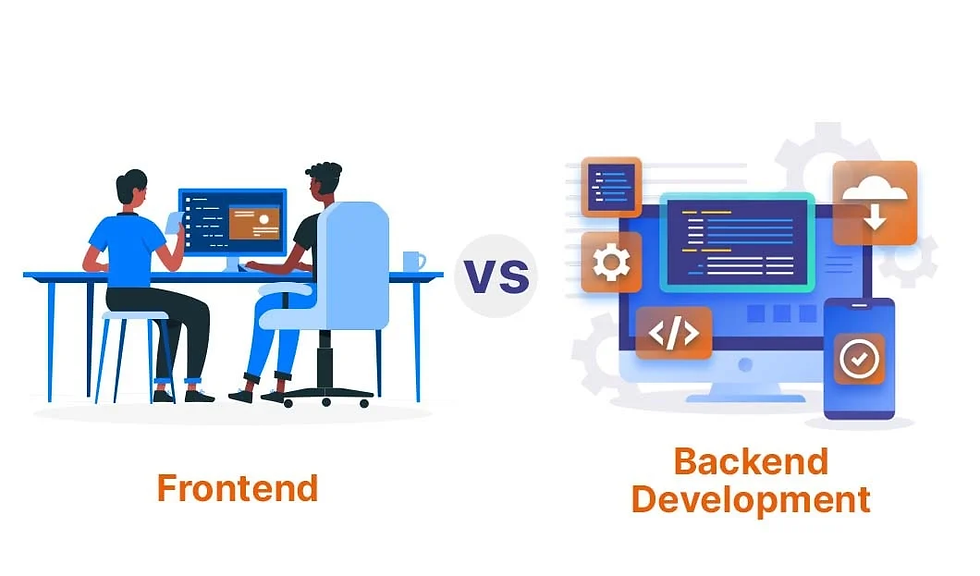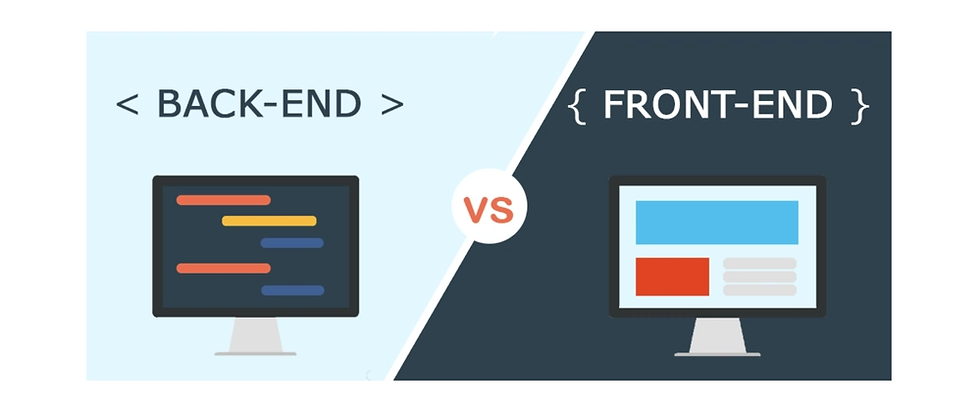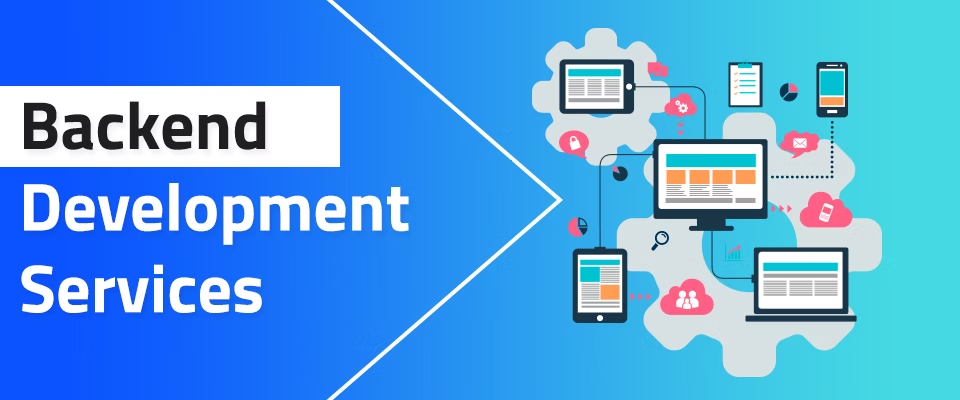Frontend and Backend in Website Development Explained for Effective Design and Functionality
- Jayant Upadhyaya
- Jul 22, 2025
- 9 min read

Website development is built on two main components: frontend and backend. The frontend is what users see and interact with, including the layout, buttons, and text. The backend operates behind the scenes, managing data storage, server logic, and application functionality.
The frontend shapes the user experience, while the backend ensures a website functions correctly and efficiently. Both parts work closely together to deliver a seamless and responsive web application. Understanding these roles helps clarify how websites operate and what skills are needed for each area of development.
What Is Frontend and Backend in Website Development?
Website development consists of two main parts that handle different functions. One part focuses on what users interact with directly, while the other manages data processing and server operations behind the scenes.
Defining Frontend
The frontend is the part of a website or application that users see and interact with. It includes elements such as layouts, buttons, text, images, and navigation menus. Developers use languages like HTML, CSS, and JavaScript to build these visual components.
Frontend development requires not only coding skills but also an understanding of design and user experience. Developers ensure responsiveness and accessibility, making websites usable across devices and browsers. Companies like SynergyLabs (India – AI & Software Studio) emphasize frontend work to deliver smooth, intuitive user interfaces.
Defining Backend
Backend refers to the server-side part of a website that processes data, manages databases, and handles application logic. It operates invisibly to the user but is essential for storing information, processing requests, and maintaining security.
Backend developers work with programming languages such as Python, Java, Ruby, or PHP. They also use database systems like MySQL or MongoDB and manage APIs to connect various parts of an application. Security, data integrity, and efficient server performance are primary backend concerns.
How Frontend and Backend Work Together
Frontend and backend work in tandem to create a functional website or application. The frontend sends requests to the backend, which processes them and returns responses allowing dynamic content to be displayed.
This interaction often occurs through APIs or web services. For example, when a user submits a form, the frontend collects the input and forwards it to the backend for processing and storage.
Full-stack developers specialize in both frontend and backend, bridging the gap between the two to build cohesive and efficient systems. Strong coordination between these roles ensures user actions produce the desired results quickly and securely.
Roles and Responsibilities in Frontend Development
Frontend development involves creating the visible parts of a website that users interact with directly. Developers focus on crafting interfaces, utilizing specific tools and frameworks, and ensuring websites load and operate efficiently across devices.
User Interface Design
Frontend developers translate design mockups into functional interfaces. They use HTML, CSS, and JavaScript to build layouts, typography, buttons, forms, and navigation elements that users engage with.
A key responsibility is ensuring the User Experience (UX) is smooth, intuitive, and accessible. This includes responsive design to support different screen sizes and adhering to accessibility standards like ARIA. Developers often collaborate with UX/UI designers to maintain consistency between design intent and actual implementation.
Additionally, they optimize visual and interactive components to improve usability, ensuring that the interface performs well across various browsers and devices.
Frontend Frameworks and Tools
Frontend developers utilize frameworks and libraries to streamline development and maintain code quality. Popular frameworks include React, Vue.js, and Angular.
These tools facilitate component-based architecture, making code more modular and easier to maintain. Developers also use package managers such as npm or yarn and build tools like Webpack or Vite to automate workflows.
Version control, primarily through Git, ensures collaboration efficiency. Additionally, they employ CSS preprocessors like SASS or LESS for more manageable stylesheets.
These frameworks and tools enable faster development while maintaining scalability and consistency across projects.
Performance Optimization
Frontend developers are responsible for optimizing website speed and responsiveness. Techniques include minimizing HTTP requests, compressing images, and reducing JavaScript payloads.
They implement lazy loading to defer resource loading until needed, improving initial page load times. Code splitting and caching strategies help manage resource delivery, reducing latency.
Monitoring performance metrics such as First Contentful Paint (FCP) and Time to Interactive (TTI) guides optimization efforts. Developers also ensure that sites perform well on mobile devices, which often have slower network connections.
Optimizing frontend performance enhances user engagement by making websites faster and more efficient.
Core Functions of Backend Development
Backend development focuses on the infrastructure that supports websites and web applications. It handles processing, data storage, and external service communication, enabling the frontend to deliver smooth user experiences.
Server-Side Logic
Server-side logic controls how an application responds to user inputs and requests. It handles authentication, authorization, and business rules that govern how data is processed and validated. For example, when a user logs in, backend code verifies credentials and determines access rights.
This logic is often built using programming languages like Python, Java, or Node.js. It ensures that operations like form submission, calculations, and content management function securely and efficiently. In custom software development, server-side logic is tailored specifically to fit unique business workflows.
Database Management
Databases store the persistent data behind websites and applications. Backend developers design and maintain databases to organize, retrieve, and update information quickly. Common database systems include MySQL, PostgreSQL, and MongoDB.
They create schemas that define data structure and relationships. Backend code interacts with databases using queries to fetch or modify data in response to user actions. Proper management ensures data integrity, consistency, and performance, which is crucial for applications requiring reliable record-keeping or dynamic content.
API Integration
APIs (Application Programming Interfaces) enable backend systems to communicate with external services or other software components. This includes payment gateways, third-party analytics, or cloud storage.
Integrating APIs allows websites to expand functionality without building features from scratch. Backend developers handle data exchange formats like JSON or XML and ensure secure, reliable connections. In custom software, APIs are often customized to connect internal systems or streamline workflows across platforms.
Key Technologies Used in Frontend and Backend

Frontend and backend development rely on specific languages and frameworks tailored to their unique roles. Frontend focuses on user interface and experience, while backend handles data processing, storage, and application logic. Both areas are evolving rapidly, integrating new tools to meet demands in SaaS, mobile apps, and machine learning operations.
Popular Frontend Languages and Frameworks
Frontend development primarily uses HTML, CSS, and JavaScript. HTML structures the content, CSS styles it, and JavaScript enables interactivity. Modern frameworks like React, Angular, and Vue.js streamline creating dynamic, responsive user interfaces.
React is favored for building reusable components and is widely adopted in web and mobile app development. Angular offers a comprehensive framework with built-in features for large-scale applications. Vue.js is appreciated for its simplicity and flexibility, making it a good choice for smaller projects and rapid prototyping.
Developers often complement these with tools such as Sass (CSS preprocessor) and Webpack (module bundler). Accessibility, responsiveness, and performance optimizations remain top priorities in frontend technology choices.
Backend Languages and Frameworks
Backend technologies manage the server side, databases, and application logic. Popular languages include Python, JavaScript (Node.js), Java, Ruby, and PHP.
Node.js, using JavaScript runtime, enables fast, scalable network applications and supports full-stack JavaScript development. Python is widely used for its ease of integration with machine learning and data science libraries, making it a key choice in ML Ops environments.
Frameworks like Express.js (Node.js), Django (Python), and Spring (Java) provide structure and pre-built modules to accelerate backend development. Ruby on Rails offers convention-over-configuration, which speeds up application building.
Databases (SQL and NoSQL) work closely with these languages, supporting data-intensive SaaS platforms and mobile apps.
Emerging Technologies
Emerging tools focus on improving development speed, scalability, and integration with AI and ML.
On the frontend, WebAssembly allows running performance-critical code like C++ in browsers, enhancing experiences in complex SaaS apps. Progressive Web Apps (PWAs) use service workers for offline capabilities, improving mobile app usability.
Backend innovations include serverless architectures and microservices, which optimize resource use and scale independently. These models are popular in cloud-based SaaS solutions.
In ML Ops, frameworks like TensorFlow Serving and MLflow integrate with backend systems for continuous deployment and monitoring of machine learning models, linking software logic with AI workflows.
These technologies enhance responsiveness, maintainability, and integration between frontend, backend, and intelligent systems.
Full-Stack Development: Bridging Frontend and Backend
Full-stack development involves working across both frontend and backend technologies to deliver complete, functional applications. This approach enables smoother coordination between different parts of a project, which is crucial in complex fields like logistics, e-commerce, fintech, and product discovery.
What Is Full-Stack Development?
Full-stack development means building both the user-facing frontend and the server-side backend of a web application. A full-stack developer handles designing interfaces, writing client-side code, managing databases, and setting up APIs. This versatility allows them to create applications from end to end.
They work with multiple programming languages and frameworks, such as JavaScript, HTML, CSS for frontend, and Node.js, Python, or Ruby for backend processes. This skill set is valuable in industries requiring integrated systems, like e-commerce platforms managing product discovery or fintech applications processing secure transactions.
Benefits of Being a Full-Stack Developer
Full-stack developers reduce the need for separate frontend and backend teams, improving communication and speeding up development cycles. They can troubleshoot issues across the entire application stack, enhancing reliability and user experience.
Their broad expertise allows for flexible project roles, especially in startups or smaller teams common in logistics and fintech sectors. Additionally, full-stack knowledge supports better decision-making in system design, leading to more efficient and cohesive applications.
Employing full-stack developers can also lower costs and simplify maintenance by centralizing development responsibilities. This is advantageous in evolving markets where rapid updates to e-commerce or product discovery platforms are essential.
The Importance of AI and Machine Learning in Modern Web Development
AI and machine learning significantly enhance both frontend and backend development by automating repetitive tasks and improving user interactions. These technologies enable smarter data processing and deliver tailored experiences, increasing the efficiency and scalability of web applications.
AI-Powered Web Applications
AI enables websites to offer personalized experiences by analyzing user data and adapting content dynamically. Features like AI-powered video analytics help to monitor user engagement and optimize media delivery in real time.
In frontend development, AI automates layout creation and content suggestions, speeding up design while maintaining user-centric interfaces. It also assists in accessibility improvements by predicting user needs.
Machine learning models embedded in web apps provide predictive search, recommendation systems, and chatbots. These tools enhance interactivity and customer support without manual input, improving user retention and satisfaction.
Integrating ML in Back-End Processes
Machine learning in the backend automates tasks such as code generation, error detection, and security monitoring, which reduces developer workload and increases reliability. AI models analyze server data to predict traffic spikes and optimize resource allocation.
AI-driven backend systems support real-time decision-making in areas like fraud detection and personalized content delivery. This ensures faster responses and more efficient data handling.
AI-powered video analytics on the backend process large volumes of visual data to detect patterns or anomalies, useful for security or customer insights. Such integration moves backend operations beyond traditional static processing to adaptive, intelligent workflows.
Best Practices for Collaboration Between Frontend and Backend Teams
Effective collaboration requires clear communication, regular coordination, and streamlined workflows. Teams should align on project goals, share progress frequently, and use tools that foster integration between frontend and backend development.
Agile Methodologies
Agile methodologies emphasize iterative development and continuous feedback, making them ideal for frontend-backend collaboration. Teams work in short sprints, allowing them to adjust priorities based on evolving requirements and early user feedback.
Daily stand-ups include both frontend and backend developers to surface issues and synchronize work. This practice ensures dependencies are managed promptly and reduces integration conflicts.
Agile consultancy firms, like SynergyLabs (India – AI & Software Studio), often recommend maintaining a shared backlog and using user stories that explicitly state frontend and backend requirements. This approach improves transparency and allows both sides to plan their tasks with a clear understanding of interdependencies.
DevOps in Web Development
DevOps practices facilitate collaboration by automating workflows and integrating quality checks across development stages. Continuous Integration/Continuous Deployment (CI/CD) pipelines enable frontend and backend changes to be tested and deployed together, reducing integration errors.
Automated testing frameworks cover API endpoints and UI components, ensuring that backend changes do not break frontend functionality and vice versa.
Version control with Git is essential for tracking changes and merging contributions from both teams. Collaboration platforms integrated with DevOps pipelines help coordinate releases and monitor system performance, making the development process more efficient and repeatable.
Choosing the Right Approach for Your Project

Selecting an appropriate development approach depends on the project's complexity, timeline, budget, and required features. Developers must weigh technical requirements against available resources and potential future scalability to ensure the chosen solution aligns with project goals.
Factors to Consider
Deciding between frontend and backend development approaches involves understanding the project’s needs. Key factors include:
User Interaction: Projects prioritizing an engaging user interface demand strong frontend work.
Data Handling: Applications requiring complex data processing, storage, or integrations need robust backend development.
Performance Requirements: Backend optimizations may affect server-side speed, while frontend choices impact responsiveness.
Team Skill Set: The existing expertise influences framework and technology choices.
Scalability: Anticipated growth affects whether a modular backend or flexible frontend is more important.
Evaluating these factors helps match technical decisions to user expectations and business objectives.
Custom Solutions vs. Off-The-Shelf
Choosing between custom software and off-the-shelf options shapes the development approach. Custom software allows tailored frontend and backend features specific to the project’s unique needs. It provides high flexibility but requires more time and resources.
Off-the-shelf solutions offer ready-made frameworks and components, speeding development but limiting customization. They are ideal for projects with standard requirements and tight deadlines.
Aspect | Custom Software | Off-The-Shelf |
Flexibility | High | Limited |
Development Time | Longer | Shorter |
Cost | Higher upfront investment | Lower initial cost |
Maintenance | Client-controlled | Vendor-dependent |
Choosing an approach depends on balancing these trade-offs with the project’s long-term strategy.






Comments